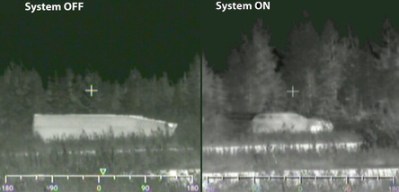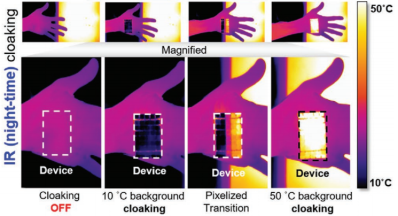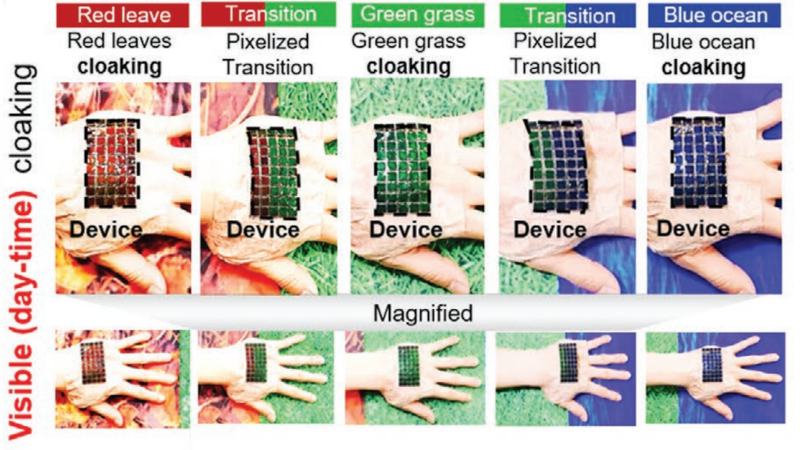An invisibility cloak may seem like science fiction, but despite that, many scientists and engineers have put much time into developing the concept, pushing it closer to reality. A device which detects the nature of its surroundings and changes its own properties to blend in may be complex, but a multitude of examples in the animal world show that it’s not impossible to achieve.
A team from Seoul National University recently developed a flexible material designed in part as a flexible “cloaking” material. We’ll take a look at the underlying concept behind such devices below, and look at how this work furthers the state of the art in the field.
Hiding in Plain Sight
Many cloaking devices have been theorized over the years. Much investigation has been done into advanced metamaterials that are able to interact with varying wavelengths of light, and through some very advanced physics, hide objects from view. So far, these devices largely remain on paper only, with a few experiments able to effectively “cloak” objects from precise wavelengths and certain vantage points. At our current level of technology, more practical efforts focus on what is known as active camouflage. This is more akin to the way animals like squid and chameleons alter their appearance to match their surroundings. Active camouflage is a two-part process; first, the surroundings must be perceived, and secondly, the object to be hidden must change its appearance to match.

The simplest concept of active camouflage is to cover an object, person, or vehicle in screens. By using cameras to image the surrounding area, the screens can be used to display what is on the other side of the object to an observer, effectively hiding the object from view. However, many challenges have thus far prevented its practical use. Accurately capturing an object’s surroundings can be achieved with cameras, but a full 360 degree view is required in order to properly hide an object from all directions. This can require an impractical number of cameras to achieve. Additionally, resolution limitations and lens distortions serve to further reduce the viability of such methods. Furthermore, current display technologies are often heavy and consume significant amounts of power. Any lag in the transmission of image from camera to screen can also spoil the effect when the object or its surroundings are moving.
A test by Top Gear in 2012 did a great job of showing the limitations of this method, with a Ford Transit decked out with cameras and mostly covered in screens. The final effect achieved was one of mild camouflage at significant distance, but virtually useless at close to medium range. The rig also had huge power requirements, needing a diesel generator to supply enough current to run the many screens.
Camouflage, So Hot Right Now

Similar efforts have been made in the realm of thermal camouflage, intended to hide military vehicles from sensors in the infrared spectrum. BAE Systems developed ADAPTIV, a system consisting of hexagonal tiles installed on the outside of a military vehicle. Each tile contains a Peltier element, enabling it to be heated or cooled as required. The tiles can be controlled to either match the temperature of the vehicle’s surroundings, or to mimic the thermal signature of an innocuous vehicle or object. The technology could prove useful to hide vehicles from observers with thermal imaging gear, and potentially even help reduce the likelihood of a successful hit from a heat-seeking warhead.
As of 2020, there has been no confirmation that such technology has seen use in the field. The possibility exists that it could be used in top secret covert operations, akin to the stealthy Black Hawk employed by the US military. However, the system does have a major flaw — the heat generated by the host vehicle still has to go somewhere. While externally-applied panels may help hide the vehicle’s thermal signature from some aspects or vantage points, exhaust plumes or simply warming the surroundings could be a dead giveaway. The system also does nothing to protect against other forms of detection, like radar.
Camouflage Skin Shows a Proof of Concept, But Still Science Fiction

The recent South Korean designed “artificial skin”, described in a scientific paper, is interesting for two reasons. Firstly, it aims to work on the human scale, rather than for vehicles or larger objects. Secondly, it has two functional modes; a thermal camouflage mode, and a visual camouflage mode. In the thermal mode, a grid of “pixels”, each consisting of a Peltier element, can change temperature to mimic the thermal signature of the background. Alternatively, it can be used for visual camouflage, as each pixel is also coated with thermochromic crystals that change colour depending on temperature. When below a certain temperature, the pixels are black, but as they heat up, they change from red to green to blue. One limitation is that the device can only perform one type of camouflage (thermal or visual) at a time, not both at once because the visual signature is dependent on the temperature of the pixels.

Unfortunately, the artificial skin is not yet a practical camouflage device. The basic operation of the Peltier elements and thermochromic coating in a flexible form factor have proved workable. However, the panels produced thus far have been of a small size, and feature no ability to sense their surroundings. Instead, they have been manually controlled to match their surroundings in a laboratory environment. Experiments are ongoing with small cameras, however, mapping a two-dimensional image onto a moving, flexible sheet will pose challenges.
While practical devices don’t yet exist, the world of active camouflage promises to grow more interesting as new display, material, and detection technologies come to the fore. At our current level of sophistication, crude designs have been achieved, with little practical application thus far. It’s likely that we’ll need to see advances in several other base technologies before active camouflage becomes mainstream, akin to the way the lithium polymer battery and advanced microelectronics enabled the creation of the quadcopter drone. Until then, dreams of invisibility will remain just that!

















Good hacks! Or at least I hope those are right words muggles use for doing something simple in complicated and impractical way. I love it.
Nice, now do that without leaking RF noise from all that “stuff” switching on and off at high frequencies.
aye aye sir!
Looks primitive like a scaly man fish.
Thermoptic camouflage just as the Ghost in the shell predicted. Fun times, fun times indeed.
Got to ask how long such a system can function – if you are actively cooling the outside to match thermally all that heat must stay ‘contained’ inside the system – some leaking can be allowed, but if you go venting all the generated heat they might not see your thermal signature, but you have a big neon hot zone pointing right to you… How long can it hope to run without cooking itself or its occupants/ being unable to keep up with its own thermal output?
Very interesting idea, but I’m not sure it beats a simple camouflage netting with the thermal reflecting keep all the heat in elements in most situations.
As the peltier can activly cool as well as heat, i guess you must run and hide in a dark/cool background area once you have maxed out your internal heat storage.
imagine having 50% IR radiation behind you, you should be able to transfer heat from the area without radiating background to the area with radiation.
i think i got it backwards as coling also generates heat. you would probably hide where there was moderate ir radiation in the background?
I’d imagine the peltier junction ir one doesn’t have much HF EM noise.
Even if it is quiet noisy its not looking like it will make any sort of effective antenna to really help send that noise far enough (though I don’t have enough detail to really say that categorically)..Going to be really hard to detect in that case – unless you have studied the function and know exactly what frequency and patterns it will create to be able to pull it out of the general EM noise of the world, and just changing the switching frequency in the software can obfuscate that. I think its own thermal emissions will likely be the easiest thing to detect.
The massive problem with all of these systems that keeps getting ignored is that they only work for one viewing angle of if the background is very close to the cloaking system. Take the top gear photo above and imagine that the camera was placed *literally anywhere else* other than the carefully composed spot where the image actually lines up on the background…
Same problem for this material.
possible solution might be something like ” looking glass” that projects different images depending on view angle.
https://lookingglassfactory.com/
better link:
https://lookingglassfactory.com/tech
No mention of the purely passive lenticular sheet system demoed on YouTube? Just some cheap plastic sheet, but very effective!
I was thinking about this a while ago and had an idea that might work at distances of over 100m or so. Basically at a large enough distance you can’t distinguish between a uniform coloured area, vs a point light source on a black background. This is how the yehudi lights system worked back in WW2. In a situation where you knew the direction of viewing, you could get away with an array of led’s, where the brightness and colour are tailored to mimic the background. You’d need to factor in things like the intensity vs angle of the led’s as well.
For camoflage from most angles, you could use an led screen behind a lens. The lens would act as the pixel of light and the pattern on the screen would show the colour/brightness of the pixel at a particular angle. You would need cameras and processors to work out those angles etc. There would be a lot of calculation needed and the system wouldn’t work well close up. It would require a lot of power too.
An even more speculative design would use some sort of active diffusion pattern with a laser passing through it. Basically a hologram video being played over the surface.
Then of course you have your optical metamaterials.
Interesting random find also when searching to see if anything new military online… not quite military… more magic and shark related: https://youtu.be/jgkuZLGBQdg?t=41
Thoughts of the range of the electromagnetic spectrum methods comes to mind.
One that is interesting military that I am aware of though highly not disclosed from my situation perspective is this suite that looks impressive and isn’t appearing as a first gen suite either, the G.I. Gen 6 Nanophotonic Refraction Stealth Operator Suit: https://www.harrysarmysurplus.net/military-surplus-stealth-invisibility-suit-generation-6.html
This is a joke, right? It’s a rubber chem suit, and then a picture of just the background with no suit?
That’s government R&D, spending and disclosure for us.
Reminds me of craft that are so expensive and six sigma somewhat lifecycle paradigm of thinking like they’re not supposed to be able to crash and they crash for a reason. What is the real intent?
Appreciate the sanity check Elliot!
Looks like a $~4000 suite here. https://www.amazon.com/Nuclear-Radiation-Demron-CBRN-Suit/dp/B07DBV824T
Makes those certain projection screens methods look impressive without the markup.
https://www.youtube.com/watch?v=KckHomYdiFc
More of a slowly back on task method: https://en.wikipedia.org/wiki/Adaptiv
this is thermochromatic?
not what i was initially thinking of.
it needs to use a different material, one recently “discovered”
(or de-classified and falsely presented as a recent civilian invention)
until its full-HD, you dont get the full mind-bending/mind-breaking effect.
imagine walking around whenever, wherever, with no permission!
imagine the ghost sightings you could spur!
the unauthorized self-guided tours of all the facilities you could imagine!
and of course, getting the king’s treatment at every store you visit…
using this on unsuspecting individuals may cause long-term mental harm,
or just a belief in things deemed non-existant
the screen or suit which stops light, is relative its the projection and throw or distance to match reality, as well as curvature, the math is complex but i believe possible.